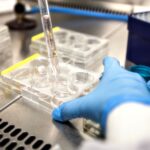The World Health Organisation estimates that between 48 million couples and 186 million individuals globally live with infertility.
Female infertility can be caused by issues ranging from problems with the pelvic organs (ovaries, uterus, or fallopian tubes), to the endocrine system and more. In men, it’s usually caused by a problem with the sperm.
Fertility treatment advances
Of course, whether infertility lies with the man or the woman, we know it can cause a great deal of emotional and physical stress – particularly for people finding it difficult to conceive over long periods of time and those whose time is of the essence.
In the UK alone the Human Fertilisation & Embryology Authority (HFEA) reports that from 1991 to 2019 there were approximately 1.3 million IVF cycles; in 2019 it reports there were 53,000 patients who received 69,000 fresh and frozen IVF cycles, while 5,700 cycles were completed with donor sperm, all of which has resulted in 390,000 babies.
What makes those statistics truly remarkable is how they reflect the incredible medical advances in treatment during that period. For instance, the HFEA records that in 1991 patients aged 35-37 and 38-39 years experienced a live birth rate of just 6% per embryo transferred; by 2019 this had increased to 25% and 19%, respectively. Whereas the multiple birth rate has reached 6%, from 28% in the 1990s.
Equality is vital
As we approach International Women’s Day on March 8, I like to reflect on how these advances and achievements have helped millions of women, and the men who support them, to have happy, healthy babies when otherwise they would not have been able to conceive.
Equality in healthcare is a key aim for the International Women’s Day movement – and I firmly believe that allowing more women – and couples – to easily access fertility and assisted conception care is fundamental to that equality.
Historically, fertility treatment was predominantly sought by people who were infertile, however, those now seeking to have assisted conception include single people, same-sex and trans couples, cancer survival, older women, and those with an hereditary (genetic) disease.
Technology is driving change
In today’s economic climate and empowered society, the need for great accessibility, affordability and personalised practice take on renewed importance.
Technology is one of the key advances allowing this to happen. Fertility treatment delivery is on the cusp of a new era as the digital shift, accelerated by the pandemic, becomes the new normal of vastly improved patient services, more efficient and effective clinic operations, resulting in more successful pregnancies.
I’m very excited about how technology is shaping the future of fertility care and outcomes for women and couples. It will allow practitioners to quickly match patient needs with the right expertise and in turn offer personalised and supportive ‘always-on’ care using a combination of in-person and virtual appointments.
For those seeking fertility treatment, this will mean greater peace-of-mind and fewer stressful situations, resulting in successful outcomes and healthy babies.
 Professor Luciano Nardo is a board-certified obstetrician, gynaecologist and expert in reproductive medicine and surgery. He has 20 years of clinical practice and academic focus on assisted conception, female and male infertility, reproductive endocrinology, miscarriage and all aspects of benign gynaecology. He is also Founder & CEO of NOW-fertility.com
Professor Luciano Nardo is a board-certified obstetrician, gynaecologist and expert in reproductive medicine and surgery. He has 20 years of clinical practice and academic focus on assisted conception, female and male infertility, reproductive endocrinology, miscarriage and all aspects of benign gynaecology. He is also Founder & CEO of NOW-fertility.com

